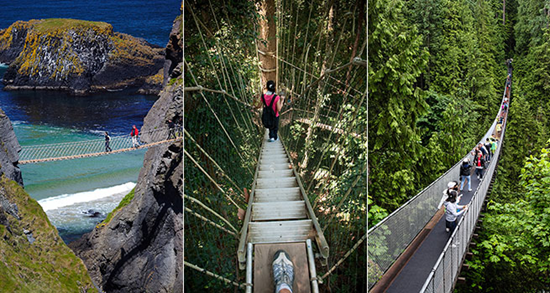
Take a chance on these 8 thrilling suspension walkways
By Catie Leary, Mother Nature Network, 29 September 2014.
By Catie Leary, Mother Nature Network, 29 September 2014.
If you're familiar with the Golden Gate Bridge or the Brooklyn Bridge, you can grasp how far humans have come in bridge building technology over just the past century or two.
And while these engineering feats are certainly worthy of recognition, there's nothing more thrilling than walking across a simple suspension bridge drastically dipping and swaying hundreds (or even thousands) of feet above the ground.
Common in mountainous areas, primitive suspension bridges are distinguished from modern suspension deck bridges by their lack of vertical suspenders, which hold the bridge flat for cars and trains. Bridges without vertical suspension instead form a catenary arch, which dips below the two fastening points. While these bridges aren't great for stable vehicle use, they're the perfect solution for able pedestrians or hikers.
Here are just a few of the world's most amazing suspension walkways, which are sure to inspire awe (or maybe fear, depending on your tolerance).
1. Capilano Suspension Bridge - Vancouver, British Columbia, Canada
Photo: Ronnie Chua/Shutterstock
If you're in Vancouver and hoping to take a break from downtown's glassy skyline, head into the North Vancouver district and take a stroll across the Capilano Suspension Bridge, a 460-foot-long walkway that runs 230 feet above the Capilano River.
Photo: Ronnie Chua/Shutterstock
Originally built in 1889 with just cedar planks and hemp rope, the bridge has undergone several renovations over the decades, including a complete rebuild in 1956. Most recently, the privately-owned attraction opened Treetops Adventures, which consists of multiple suspended footbridges weaving around Douglas firs.
2. Carrick-a-Rede Rope Bridge - Ballintoy, Northern Ireland
Photo: Serg Zastavkin/Shutterstock
Currently constructed using wire, rope and wood from a Douglas fir, this picturesque bridge links the mainland to the small island of Carrickarede. Early incarnations of this bridge were built and used by salmon fishermen as early as 350 years ago, but as the local supply of salmon ran out due to overfishing, the suspended pathway became more of a place to find tourists.
Photo: Jennifer Boyer/Flickr
This famous rope bridge isn't the only scenic attraction for which County Antrim is known. Just eight miles down the road, you'll stumble upon Giant's Causeway, one of the most surreal geological formations on the planet.
3. Taman Negara canopy walkway - Titiwangsa Mountains, Malaysia
Photo: faberfoto-it/Shutterstock
Not only is Malaysia's Taman Negara the oldest rain forest in the world (an estimated 130 million years!), it also happens to boast the world's longest canopy walkway. Located 147 feet above the ground, this famous suspended path is the best way to experience this breathtaking natural treasure.
Photo: chee.hong/Flickr
To get to the park, you can book a pricey tour from Kuala Lumpur that includes lodging, transportation and meals, but many intrepid travellers generally recommend going the DIY route to save time and money.
4. Trift Bridge - Gadmen, Switzerland
Photo: Thisisbossi/Wikimedia
Spanning 560 feet over Triftsee Lake, the Trift Bridge is the longest pedestrian suspension bridge of its kind in the Swiss Alps. The bridge and the area surrounding it receive about 20,000 visitors a year due to its perfect vantage point for viewing the Trift Glacier (seen in the background).
Photo: Thisisbossi/Wikimedia
What's interesting about Triftsee Lake is that it's actually a new lake that formed after 2002 due to the gradual melting of the lower portion of the Trift Glacier.
5. Titlis Cliff Walk - Mount Titlis, Urner Alps, Switzerland
Photo: iamnong27/Shutterstock
If you're looking for a nosebleed experience, search no further than this gem of a bridge, which is suspended 10,000 feet above sea level on Mount Titlis in the Swiss Alps. First opened in 2012, it's considered to be Europe's highest elevation suspension bridge - a title previously held by the equally precarious Salbit Bridge (also in the Alps).
Photo: iamnong27/Shutterstock
Because the bridge was built in such an extreme location, designers had to make sure it could withstand wind speeds of more than 120 miles per hour and at least 450 tons of snow. Construction materials had to be delivered by cable car or sometimes helicopter, and because builders could only work when weather permitted, the project took five months to complete.
6. Kakum Canopy Walk - Kakum National Park, Ghana
We can thank a pair of Canadian engineers from Vancouver for building this 1,150-foot-long suspended pathway through the tropical rain forest of Kakum National Park. The pathways are built with wire rope, wooden planks, ladders and a lot of rope netting to prevent people from falling.
Photo: Steve Heap/Shutterstock
The hanging bridges extend across seven treetops, treating visitors to an unforgettable chance to see the unique plants and wildlife that live on that level of the forest.
7. Via ferrata suspension bridge - Monte Cristallo, Italy
Photo: Florin Stana/Shutterstock
Photo: saiko3p/Shutterstock
Located in the Italian Dolomites in northern Italy, Monte Cristallo is a popular recreation area for hikers, climbers and skiiers. It is also the site of a well-known via ferrata that features an exceptionally precarious suspension bridge.
Via ferratas, which is translated as "iron road" in Italian, are protected climbing routes characterized by a steel cable aid that climbers secure themselves to using a via ferrata kit. To understand how climbers use via ferratas, check out the video above of someone crossing the Monte Cristallo bridge.
8. Swing Bridge - Pokhara, Nepal
Photo: Quick Shot/Shutterstock
This suspension bridge is a boon to locals who want to travel from either side of the gorge, but this activity is not for the faint of heart. Officially known as just a section of the continuing Bhalam Road, it's sometimes called the "Swing Bridge" - because it sways quite a bit. Still, it gets the job done, right?
Related on Mother Nature Network:
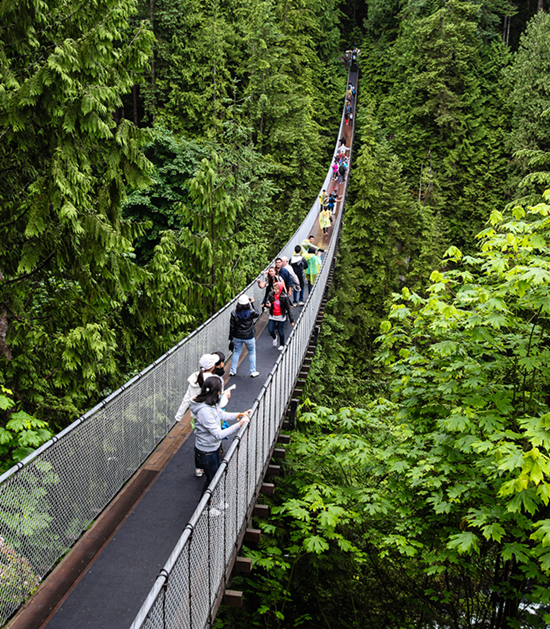
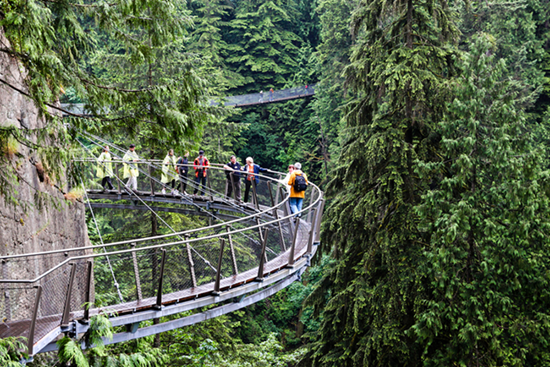
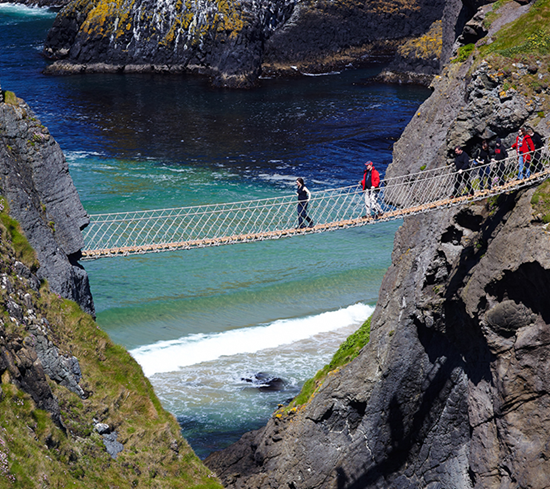
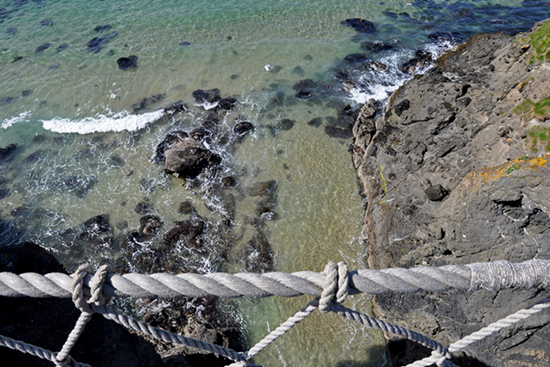



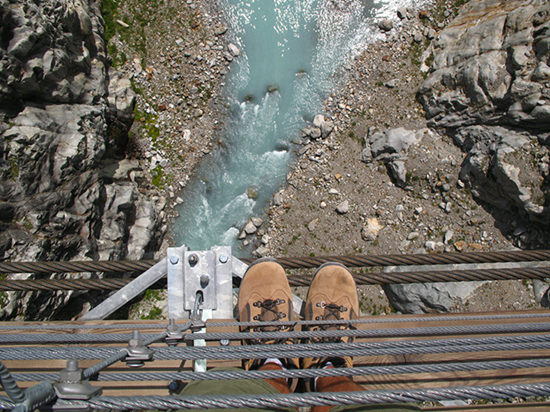
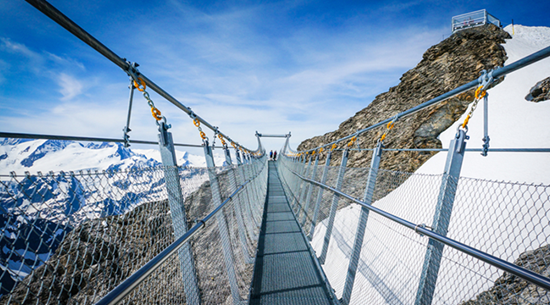

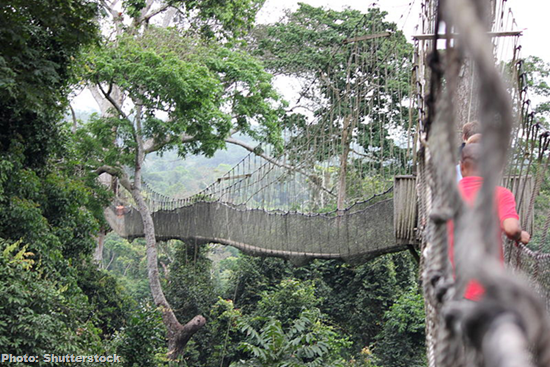

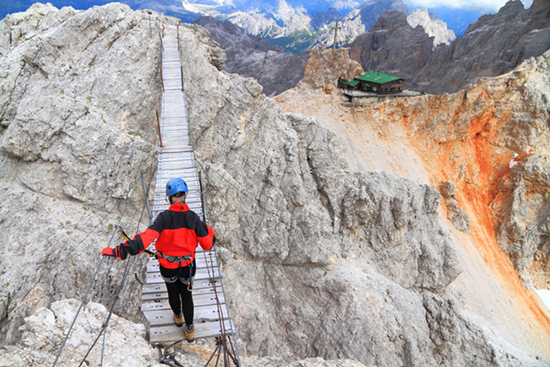
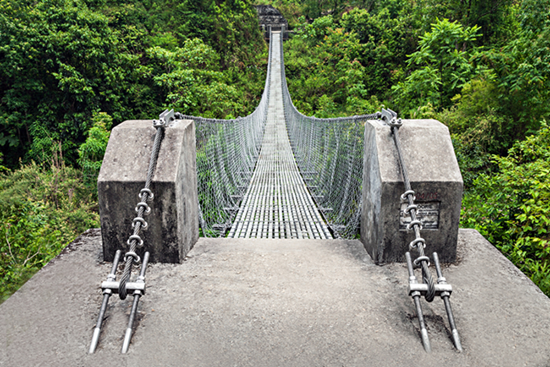

No comments:
Post a Comment
Please adhere to proper blog etiquette when posting your comments. This blog owner will exercise his absolution discretion in allowing or rejecting any comments that are deemed seditious, defamatory, libelous, racist, vulgar, insulting, and other remarks that exhibit similar characteristics. If you insist on using anonymous comments, please write your name or other IDs at the end of your message.